Just a nerd who likes to draw. And write. Kinda. my most active blog: coffeerebagels.tumblr.com
Don't wanna be here? Send us removal request.
Text
Body type and shape
1. Lean: Having a slender and toned body with minimal body fat.
2. Muscular: Having well-developed muscles and a defined physique.
3. Slender: Having a thin and graceful body shape.
4. Curvy: Having an hourglass figure with well-defined curves, particularly in the hips and bust.
5. Athletic: Having a fit and muscular body, often associated with participation in sports or physical activities.
6. Petite: Being small and slender in stature, usually referring to height and overall body size.
7. Voluptuous: Having full and shapely curves, often emphasizing a larger bust, hips, and thighs.
8. Stocky: Having a compact and solid build with a sturdy appearance.
9. Thin: Having a slim and slender body shape with little body fat or muscle definition.
10. Well-proportioned: Having balanced and harmonious body proportions, with each body part in good proportion to the whole.
11. Toned: Having firm muscles and a defined physique resulting from regular exercise and strength training.
12. Chubby: Having a plump or rounded body shape, often with excess body fat.
13. Pear-shaped: Having a body shape where the hips and thighs are wider than the shoulders and bust.
14. Hourglass figure: Having a curvy body shape characterized by a well-defined waist and proportionate bust and hips.
15. Apple-shaped: Having a body shape where weight is primarily carried around the midsection, resulting in a broader waistline.
16. Broad-shouldered: Having wide and well-developed shoulders in comparison to the rest of the body.
17. Long-limbed: Having long and slender limbs in proportion to the body.
18. Stout: Having a sturdy and robust build, often characterized by a solid and thick physique.
19. Plump: Having a pleasantly full and rounded body shape, often indicating a higher percentage of body fat.
20. Tall and slender: Being tall in height and having a slim and elongated body shape.
6K notes
·
View notes
Text
Scene Lists
I mention working from scene lists a lot, so I wanted to do a quick post about those…
What is a Scene List? In its simplest form, it’s exactly what it sounds like: a chronological list of your story’s scenes from beginning to end. However, the exact format of that list is up to you and your needs as a writer.
What Does it Include? At the very least, each scene needs to be identified by a keyword, phrase, or title that tells you what needs to happen in that scene. For example, the first scene of The Hunger Games could be “getting ready to hunt with Gale.” Or just “hunting with Gale.” At its most complex, a scene list can contain the date of the scene, chapter and scene number, beat, and a summary of the scene. Ultimately, it can include whatever works for you. This is what I include in my own scene lists:

*** not a real story, btw. ;)
What is the Purpose? Scene lists not only help you flesh out each individual scene, but they give you a “big picture” overview of your story, and they function as a handy road map while you’re writing. There’s never a point where you don’t know what you’re supposed to be writing or what you should be writing next.
Pro Tip: When I start writing, I always have a printed out copy of my completed scene list, plus a printed out blank copy of my scene list. This allows me to make changes (on the blank copy) if I need to shuffle things around along the way. It’s a manual way to keep track of the changes you make rather than crossing things out on the other version (which can get messy.)
How Do You Make One? You can do a scene list in a notebook, a scrap of paper, or you can create one in your favorite Word Program. If you use a writing app or program like Scrivener, you can create one in there. I use Word for mine.
————————————————————————————————-
Have a question? My inbox is always open, but make sure to check my FAQ and post master lists first to see if I’ve already answered a similar question. :)
394 notes
·
View notes
Text
Challenge: 100 Hours of Writing
That sounds like a lot, doesn’t it? Writing for an hour or two can be exhausting. Imagine doing it for 100 hours.
Nobody can write for four days straight. That’d be insane.
The great thing about writing is that you can spread it over as long a period as you want. In fact, if you write for about two hours per week, you will hit the 100-hour milestone in a year. That is
17 minutes every day,
or 24 minutes every working day,
or 30 minutes every other day,
or two 1-hour sessions,
or one intense 2-hour session every week.
That sounds doable, right? You can also mix and match. Write a bit every day, then take a break and do a long writing session on Saturday night. As long as you stay consistent and write for at least two hours every week, you’ll be on your way to 100 hours.
What Can You Do in 100 Hours?
Aside from earning this award (if you use Writing Analytics), 100 hours is enough to finish a draft of a novel.

If you can write about 800 per hour or 1,600 words per week on average, you will write 80,000 words in a year. That is
230 words every day,
or 320 words every working day,
or 400 words every other day,
or 800 words twice weekly,
or 1,600 words once a week.
Again, you can mix and match. Do something else every week. Get to 1,600 every week, and you will reach your goal.
Keep in mind that these numbers are on the conservative side. I consider myself a slow writer, and I write faster than that. Some people can blaze through 1,600 words in 30 minutes.
The Challenge
This week, I want to challenge you to see if you can fit two hours of writing into your weekly schedule. It doesn’t matter if you power through the whole thing at once or write for 17 minutes every day.
Here’s the important part: If you can write for two hours per week, you have what it takes to finish a book.
If you’d like to write along with us, join the challenge in Writing Analytics:
https://app.writinganalytics.co/challenge/64917a6fe7b6ddfbda7281e6
The app tracks your writing time and lets you set time goals, which makes this super easy.
393 notes
·
View notes
Note
Hiya! I'm a new writer, aside from an odd bit of fanfiction here and there. I'd like to finally begin an original story. What are your initial actions when beginning a new work? Aside from that, do you have any more tips for me to adhere to? I'm not looking to publish or anything, this is purely for fun.
Guide: Starting a New (Long Fiction) Story
Whether you’re writing for practice, publication, or fun, the process for writing a new original story is different for everyone and often depends on the project itself. Here are some things to consider as you start to prepare and get started on your new story.
1. To plot or not to plot?
The first thing you’ll want to do is decide how much you want to plot out the story before you start writing. Some writers are avid plotters, planning out every detail of their story before they begin. Other writers prefer to take an idea and wing it, and some people plot as they go. At the very least, it’s a good idea to make sure you know the following before you start writing:
Who is your protagonist? What do they want, why do they want it, and how are they going to get it?
When and where is the story set? What parts of this setting will play the biggest role in the story and how?
Who or what is the antagonistic force? Every protagonist needs an antagonist to work against them, creating obstacles they must overcome as they try to reach their goal. An antagonistic force is anyone or anything that creates those obstacles, whether a super villain, overbearing but well-meaning parents, a disease, a natural disaster, or a plague of zombies.
Know your beginning, middle, and end. Before you start writing, it’s a good idea to have a mental picture of how the story starts (your character’s normal life before everything turns upside down), what’s happening at the midpoint (what happens to raise the stakes and give the protagonist a big push toward the “final showdown” with the antagonist), and how the story ends (does your character defeat/survive the antagonistic force? Do they reach their goal? How does your character or their world change as a result?)
2. Research and Inspiration…
Whether or not you decide to plot, you will probably want to spend a little time doing some research and looking for information. If you are choosing to plot, you may want to do this afterward or during your plotting phase. Ultimately, you’ll want to consider whether there are any elements in your story that you need to know more about before writing them. This might include things like learning what it’s like to be deaf, how castles are laid out, or what kinds of plants and flowers typically grow in forests. If you’re setting your story in a real place, or are using a real place as inspiration, you may want to learn more about that place. If your story takes place in a particular era or involves a particular event or type of event, you will want to research those. For inspiration, you may want to look for pictures of everything from characters and clothing to buildings and places. Some writers enjoy putting together pinterest or tumblr galleries to house inspiring pictures. You may also want to put together character, setting, and story aesthetics (collages), put together a writing playlist that has the right feel for your story, or even travel to places or do activities that are related to your story.
3. Planning, preparation, and organization.
If you’re going to wing it, you’re pretty much ready to get started with writing now. However, if you’re going to plot your story, this is the point where you might want to do a little more planning and preparation before you start writing, and depending on how much stuff you accumulate through these early stages, you’ll probably want to do a little organization, too.
When I start a new story, I always do three things:
– purchase a three-ring binder and dividers for keeping track of my story plans– set up a story specific folder on my desktop with necessary subfolders– set up a story specific folder in my browser with necessary subfolders
I like to decorate my binder with a printed out aesthetic picture and a pretty title on the side. The divider tabs for my binders usually contain sections like: characters, setting, outline/scene list, notes, rough draft, etc. If there is more than one major setting, sometimes I’ll give each setting their own divider. It really just depends on the needs of my story, and sometimes I re-organize my dividers as the story progresses and my needs evolve.
My desktop folder usually contains the following subfolders: drafts, storage, notes-ideas, character stuff, setting stuff, inspiration, and then sometimes I do additional subfolders… like my “character stuff” subfolder might have subfolders for each character or characters in each specific setting.
My browser folder is usually kind of a mess. I will sometimes do subject-specfic subfolders, but usually I just bookmark whatever I need to and make sure the bookmarks I access the most are at the top of the list.
Again, you will probably add to all of this as you actually get into the plotting phase. I consider this phase and the plotting phase to go hand-in-hand. This is really just about getting everything set up and ready to go.
This is also a good time to figure out things like a writing schedule (if you need to set one), daily or weekly word count goals, and get your writing space organized if you have one.
4. Plotting…
There are many different ways you can plot your story, all depending on what works best for you and the needs of your story. Some writers simply like to come up with an exhaustive summary of events from beginning to end. Others like to do some sort of outline. You may want to do a timeline and a scene list as well. My post how to outline a plot will walk you through some of the different options, and my plot and structure master list has lots of other posts that may be useful to you during this time.
5. Start writing!
Once you’ve gotten your story plotted out (or not, if you’re choosing not to plot), it’s time to sit down and start writing. Here are some things to keep in mind:
– This is the very first draft of your story and it’s going to be ROUGH, which is why it’s often referred to as the “rough draft” or “zero draft.” This draft isn’t going to be perfect. It’s going to be messy, ugly, meandering, and kind of awful, and THAT’S FINE!!! This is just the rough sketch or mockup. You’re going to improve upon it later.
– Because this is the first draft, now is not the time to worry about word choice, sentence structure, word play, grammar and punctuation, flawless story structure, etc. Just get the story down to the best of your ability. You’re going to make it pretty in the later drafts.
– Also, because this is the first draft, don’t be afraid to go a little hog wild. You don’t have to worry about word count and having a tight story now. Feel free to go off on tangents, delve into fluffy scenes, and follow weird threads. Dive in and explore your world and its characters. This exploratory process allows you to kind of throw everything at the wall and see what sticks. A lot of the time you’ll end up discovering gems you hadn’t considered initially. Again, you can figure out what to cut out later on.
– AGAIN… DO NOT EDIT AS YOU GO. I mean, look… sometimes, more experienced writers develop a process where they do edit as they go, and that’s fine. But until you’ve written enough stories from beginning to end to know what works for you, don’t trouble yourself with editing as you go. The most important thing right now is to write this story from beginning to end. Once you get to the end, you can go back and make it pretty.
– It’s okay to feel frustrated and have days where you need to take a break. You may have days where you just want to delete the story and move on, but don’t do that. If you need to, walk away from it for a few days or a week and come back to it later. If the story still isn’t working for you, save everything and start on a new project, but never delete what you have no matter how much you feel like you hate it now. You never know when inspiration will strike and you’ll decide to go back to an old project.
Good luck with your story!
411 notes
·
View notes
Text
Writing Game: Let's Create a Character
Creating a character is hard work, but it can also be very fun. This little game is a way to help you with that. You can use a randomizer to choose a number for you. The number will determine some aspects that you can use as a basis for creating an interesting character. You can also use your birthday for this.
Part 1: Names
Choose a number for the letter that your character's name starts; you can use the day you were born:
1. A 2. B 3. C 4. D 5. E 6. F 7. G 8. H 9. I 10. J 11. K 12. L 13. M 14. N 15. O 16. P 17. Q 18. R 19. S 20. T 21. U 22. V 23. W 24. X 25. Y 26. Z 27. Ä 28. Ö 29. Ü 30. Ø 31. Ş
Part 2: Hair colour
Choose a number for your character's hair colour; you can use the month you were born:
1. brown 2. blonde 3. red 4. blue 5. green 6. pink 7. purple 8. white 9. grey 10. black 11. more than one colour 12. bald
3. Part: Character Traits
Choose a number for your character's characteristic traits; you can choose more than one and use your birthday for one:
1. loyal 2. determined 3. rude 4. caring 5. open-minded 6. patient 7. faithful 8. confident 9. generous 10. funny 11. impatient 12. bossy 13. mean 14. greedy 15. optimistic 16. abrasive 17. charismatic 18. witty 19. stubborn 20. arrogant 21. cunning 22. brave 23. affectionate 24. smart 25. playful 26. reliable 27. ambitious 28. creative 29. kind 30. petty 31. fearless
4. Part: Physical features
Choose a number for one character's physical characteristics; you can choose more than one and use your birth month for one:
1. freckles 2. crooked teeth 3. dimples 4. heterochromia 5. curly hair 6. wrinkles 7. glasses 8. long nails 9. tattoos 10. piercings 11. facial hair 12. moles
5. Part: Hobbies & Interests
Choose a number for one character's hobby; you can choose more than one and use your birthday for one:
1. playing an instrument 2. archeology 3. photography 4. horseback riding 5. ball games 6. birdwatching 7. dancing 8. baking 9. magic 10. history 11. travelling 12. skating 13. martial arts 14. ghost hunting 15. fishing 16. singing 17. video games 18. climbing 19. fashion 20. gardening 21. glassblowing 22. upcycling 23. cosplaying 24. swimming 25. knitting 26. makeup 27. writing 28. film-making 29. cooking 30. geocaching 31. bowling
If you like my blog and want to support me, you can buy me a coffee or become a member! And check out my Instagram! 🥰
1K notes
·
View notes
Text
Heya guys I'm back!
I'm gonna be more active here from now on. coffeerebagels became my fandom blog. This will become my safe space to reach my personal goals, so here I'll reblog writing and art tips, and when I draw or write I'll post it here. Or on coffeerebagels, I'm still in doubt. Anyway it's nice to say hi again ^^
12 notes
·
View notes
Photo





Sakimori - https://twitter.com/sakimori_st30
3K notes
·
View notes
Text
Me as a writer: Gotta add a little bit of fluff, a handful of laughter and sarcasm, and just a dash of angst.
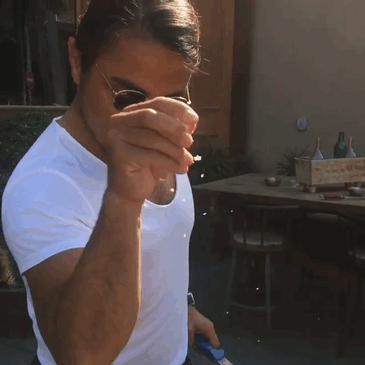
Also me as a writer: Just. A. Dash. Of. Angst.
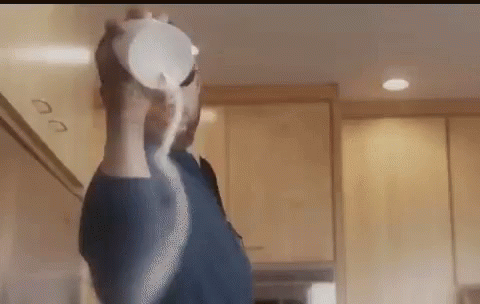
76K notes
·
View notes
Photo







Eddie Mendoza - http://eddie-mendoza.net - https://www.linkedin.com/in/eddie-mendoza-933b56b5 - https://www.facebook.com/eddie.mendoza.art - https://eddie-mendoza.deviantart.com
3K notes
·
View notes
Text
Words to Describe Hair
This began as a guide to describing Afro/curly hair but of course, I got carried away. From look and texture of hair, colors and various styles, this guide serves as a thesaurus of sorts for hair, as well as pointers for use in your writing.
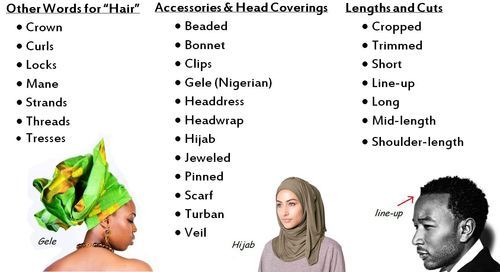
Culturally Significant Hair Coverings:
Know the meaning behind head wear and why it’s worn, when and by whom, such as a Native Nation’s headdress, before bestowing a character with it.
Head Coverings Resources:
More on various head coverings.
See here for more Islamic Veils.
See here for more on the Nigerian gele.
See here on African American Headwraps.
View our hijab and headscarves tags for discussion on these topics.
Afro - Curly - Straightened


There are many varieties of braids, twists & Afro hair styles; have some more!
African/Black Hair: Natural, Braids and Locks
African Hair: Braiding Styles 10 African Types
Describing Black (Afro) hair:
Appropriative Hairstyles: Keep in mind that Afro styles should be kept to those in the African Diaspora, such as dreadlocks, cornrows + certain and many braided styles.
Tread carefully describing Afro hair as “wild” “unkempt” “untamed” or any words implying it’s unclean or requires controlling.
“Nappy” and “wooly” are generally words to stay away from, the first having heavy negative connotations for many and the latter, though used in the Holy Bible, is generally not acceptable anymore and comes off as dehumanizing due to Animal connotations.
There are mixed feelings on calling Black hair “kinky.” I’m personally not opposed to the word in itself and usage depends on the person’s race (I’m more comfortable with a Black person using it vs. a Non-Black person) as well as their tone and context (if it’s used in a neutral or positive tone vs. negatively/with disdain). Get feedback on your usage, or simply forgo it.
See our tags “Black Hair” and “Natural Hair” for more discussion on describing Black hair.
Texture - Look - Styles
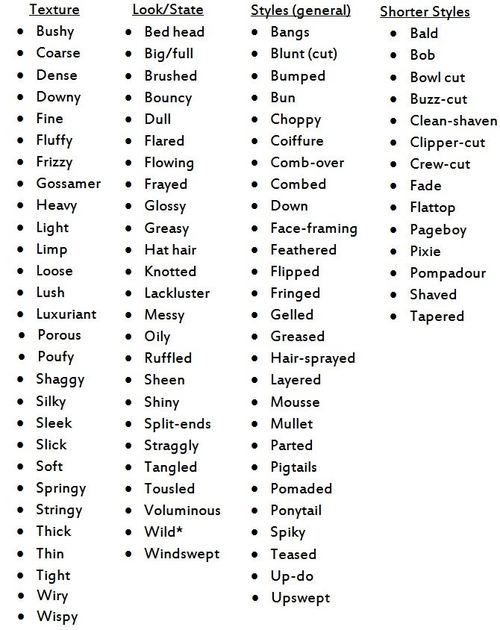
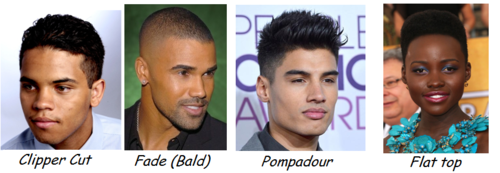
Hair Colors and Style


Writing Tips & Things to Keep in Mind:
Combination Words: Try combining words to illustrate look of hair. A character with springy coils that dance across her shoulders with every movement, the man with thick silvery hair slicked back into a ponytail…
Mind Perspective: Depending on POV, a character might not know exactly what cornrows or a coiffure style is, at least in name, and it might make more sense if they described the hairdo instead. More defining terms might come from a more knowing source or the wearer themselves. One book I read described a girl’s afro puff as “thick hair pulled up into a cute, curly, poufy thing on top of her head and tied with a yellow ribbon.”
POC & Hair Colors: People of Color’s hair comes in all shades and textures. There are Black people with naturally blond and loosely-textured to straight hair, East Asian people with red hair, and so on. Keep that in mind when coding characters if you tend to rely on hair color alone to denote a character is white vs. a Person of Color.
Related Tropes: There are tropes and discussion related to People of Color, colored hair, and light-colored hair and features.
Check out these posts on the topic: The East Asian Women + Colored Hair Trope - Black Characters & “Wild” Hair Colors - POC w/ Supernatural Colorful Features. - ‘Uncommon’ Features & POC Characters
~Mod Colette
77K notes
·
View notes
Note
Relatable
How fic writers who write English as a second language have courage to go and just publish?! I sit on around 33000 words, mostly grammatically betaed by a native speaker even, and I'm still paralyzed by fear. Because I'm still not as good as when...well, you get the drill.
In 2019, we take a deep breath and post anyway! Fic doesn’t have to be perfect. It just has to tell a story.
Do the thing! :)
2K notes
·
View notes
Photo





Karolis Strautniekas - https://www.facebook.com/strautniekas - http://strautniekas.com - https://dribbble.com/strautniekas - https://twitter.com/strautniekas - https://www.pinterest.com/strautniekas - https://www.flickr.com/photos/strautniekas - http://strautniekas.com/store - http://strautniekas.com/blog
3K notes
·
View notes
Text
*goes on urban dictionary to look up the slang words everyone uses*
206K notes
·
View notes
Photo

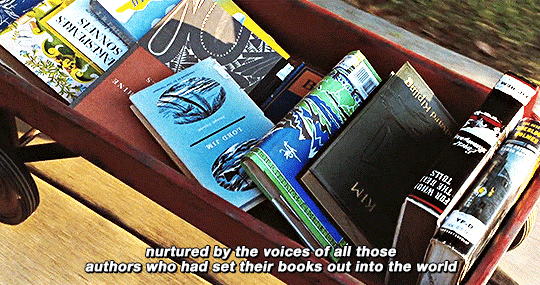
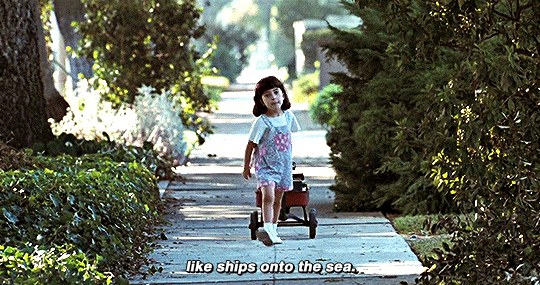
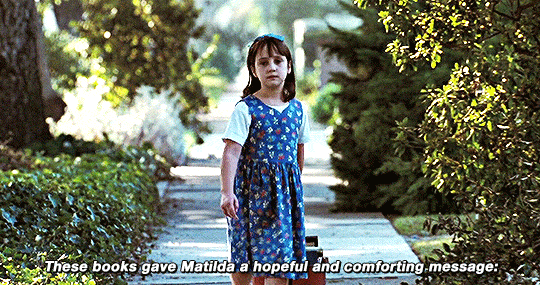
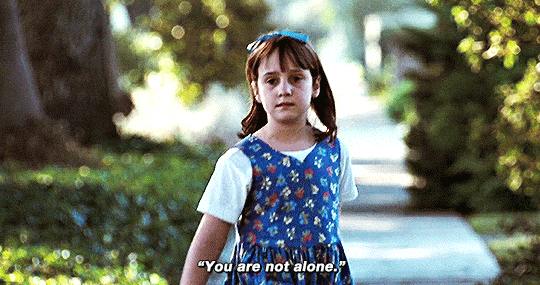
Matilda (1996), dir. Danny DeVito
315K notes
·
View notes
Note
okay, i have a problem: i'm aromantic and i don't know how the fuck romantic love works, so idk how to write a romance without falling into the "romance is more important and better than friendship" bullshit. how is romantic love different from friendship? why do people fall in love? how does it feel? why do some people work well as friends and not as lovers? wtf i don't understand anything
Thanks so much for your question, darling! Romantic love differs for everyone, so a fewof the mods have come together to give you our opinions :)
What Defines Romantic Love?
Mod Joanna says:
Hi, love! Iappreciate this question, because it’s something I’ve been working out myselffor a long time. I’m demisexual, so Ireally don’t experience physical/romantic attraction to anyone until I’ve builta friendship with them. That’s alwaysmade it difficult for me to separate romantic love from a strong friendship,because for me, they’re nearly one and the same.
But since romance is a big part of my writing (and has beenfor several years), I’ve learned much more about romantic love and how toseparate it (fictionally and in reality) from platonic love. In my experience, romantic love…
Functions, at its base, like a strong friendship. The process of meeting a person, learningabout them, becoming attached to them, desiring to spend time with them –these phases exist in all relationships. Falling in love seems to happen faster, though, because it’s acceleratedby physical attraction.
Includes physical attraction. Friends can be attracted to each other, butromantic, prolonged attraction grows and develops over time. Affection tends to “blind” or warp one’s vision,so that even mundane traits or actions can become attractive. Here’san LGF post on growing attraction!
Accelerates physical intimacy. Romantic partners, after a certain amount oftime together, have decreased physical boundaries between each other. The safer two people feel around each otherphysically, the more affectionate and comfortable they become. Often, couples start to think of each otheras physical extensions of themselves (which is why some couples feelcomfortable sharing drinks/gum/clothes etc.). This can be stronger for – but is not exclusive to – sexually activecouples.
Fosters a deep, absolute affection for a person’s strengths,flaws, quirks, and humor. It gives a desire to be closer to that person – to knowthem completely. Romantic love is along-term investment in someone’s hopes and dreams, and in helping them toachieve those dreams. It’s a hope tosee someone grow in good ways, to protect them from bad things, and to makethem happy.
Inspires growth and self-love. Feeling someone else’s affection andinvestment both spurs healthier life choices and alters one’s image ofthemselves. People in healthy relationshipsare more likely to take better care of themselves, to be more ambitious andconfident, and to be more content in hard times.
Ultimately, though, the biggest difference for me is the falling-in-love phase. It’s much more rapid, and much less controllable than the beginning phase of a platonic friendship. In contrast, the later phases of romance – facing differences and staying in love – are more trying than in extended friendship. Being that intensely close to another person is a challenge as much as it is a pleasure. Don’t forget that.
Mod Gen says:
Hey! When I saw this question I immediately had a few ideas,as I’m asexualand demiromantic and relationships for me are primarily non-physical andmore about romance and friendship. For me, romance isn’t so different fromfriendship – I’m in a relationship that also blurs the lines of being a QPR(queer-platonic relationship). Our relationship started as a friendship andslowly developed into more romantic feelings. In my opinion and experience,relationships/romance that have a basis in friendship are usually moresuccessful/healthy. Usually, romantic partners are also friends, some moreso than others. For this reason, I would say friendship is equally, if notmore, important than romance in a lot of cases (in my humble opinion).Showing that two characters who are in a romantic relationship are alsofriends is very important. They should have some sort of chemistry, orbanter, they should support each other, etc. etc.Okay, I’m about to get real sappy: for me, falling in love with someone isbeautiful. I can barely begin to put into words how much I care for my s/o,how much I miss her when I’m not around, how I can almost feel a physicalache when she’s not there, how much I want her to be happy. I know her likeI know myself (probably better, actually), and I just feel so calm when I’maround her. She puts me at ease, and simply being with her can make me feelso much better and improve my mood. We don’t even have to talk or interact.My heart doesn’t flutter when I see her; it calms.
Mod Daenerys says:
Hey there! First off, I want to say that a strong, healthyromantic relationship should also be a great friendship. In my opinion,the best romantic relationships are built off of friendships - not to mention,in fiction it is very easy to fall into the controversial love-at-first sighttrope, which it seems like you are trying to avoid. It is also my opinion thatwe tend to place more value on romantic relationships than we do onfriendships, which are equally important, if not more important for somepeople.
I’m asexual, and biromantic, so relationships in my case aremore focused on those friendship sort of aspects, whether romantic or platonic.As for falling in love, I think it comes down to having someone that you wantto be deeply, deeply close to. You find yourself wanting to place theirhappiness above your own, you start thinking in terms of ‘we’ instead of‘I’…that sort of thing. A romantic relationship seems to me to be aboutholding each other up, pushing each other to achieve your goals, while also givingthem the space and freedom to be themselves. Falling in love with someone is tohave them teach you something about yourself, about the world. There’s acertain closeness there that I think is different from friendships, and thiscan come through in very subtle ways.
In terms of why some people work better asfriends than lovers, I think it comes down to that level of closeness. Romanticpartners tend to make more collective decisions, they work towards goalstogether, they may eventually want to build a life together. Yet, we all havefriends that we love very dearly, but we know that if we tried to take on atask like that together we would be at each other’s throats - either because wehave different goals, we think differently, or we tackle problems differently,to the point that we piss each other off. There has to be a willingness to workthrough problems together, things that don’t always apply even in our closestfriendships.
I hope some of this helps you to make the distinction between romantic and platonic love, and to really explore romantic love in your fiction :) If you have any more questions, be sure to let us know!
- The Mods
If you need advice on general writing or fanfiction, you should maybe ask us!
#nice#writing#writeblr#writing tips#writing advice#romance#relationships#friendships#writing romance
825 notes
·
View notes
Text

“My battery is low and it’s getting dark.” Said Your Robot Companion. It’s the midst of an apocalyptic world.
3K notes
·
View notes
